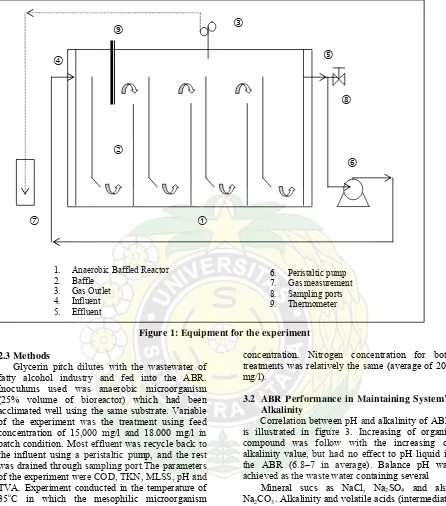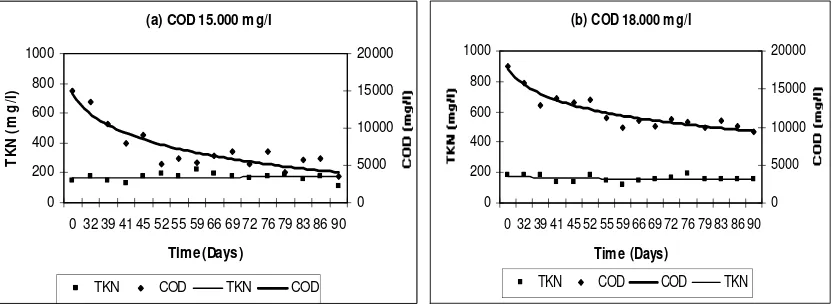Jurnal Teknik SI M ET RI K A Vol. 4 No. 1 – April 2005: 271 – 274 271
PERFORMANCE OF ABR :
CASE STUDY USING GLYCERIN PITCH AS SUBSTRATE
Maya Sarah
*)*)
Staf Pengajar Departemen Teknik Kimia, Fakultas Teknik USU
Abstract
The wastes of oleo chemical industry is categorize as wastewater and glycerin pitch. Treatment of waste water of oleo chemical industry which contains glycerin pitch using Anaerobic Baffled Reactor (ABR) was proven to be effective in treating medium level concentration (influent COD of 15.000 mg/l) with COD removal efficiency of 72%. For overall, ABR performance in reducing organic compound, influence significantly only with the feed concentration and biomass losses. Increasing of feed concentration from COD of 15.000 mg/l to COD of 18.000 mg/l followed with the increasing of biomass losess of 27%.
Key words: Anaerobic baffled reactor, Bioreactor anaerobic, Fatty acid, Fatty alcohol, Glycerin pitch, Methyl esther, β-oxidation
1. Introduction
The oleo chemical industry mainly problem is the treatment and disposal of their wastes. The wastes of oleo chemical industry is categorize as wastewater and glycerin pitch. Glycerin pitch is a viscous liquid coloring brown to dark brown with organic compound in average 1 to 2 million mg COD per liter. Glycerin pitch disposal become serious problem since it is high organic compound lead to the difficulties of biological degradation. However the dilution of glycerin pitch with the wastewater has reduced the COD less than 27,000 mg per liter.
Study on the degradation of glycerin pitch in the batch condition using anaerobic bioreactor has been conducted resulting low COD removal efficiency (35% to max 47%) [a]. Meanwhile the Anaerobic Baffled Reactor (ABR) has been proven to be effective in treating palm oil mill effluent [b] with COD removal efficiency of 90%. As oleo chemical industry is the derivation of palm oil industry, the ABR was used to treat wastewater of oleo chemical industry. The operation is in the batch condition and effluent was recycling back to the influent using a peristaltic pump.
The ABR design uses a series of baffles to force the wastewater to flow under and over (or through) the baffles as it passes from the inlet to the outlet. Bacteria within the reactor gently rise and settle due to flow characteristics and gas production, but move down the reactor at a slow rate. The most significant advantage of the ABR is its ability to separate acidogenesis and methanogenesis longitudinally down the reactor, allowing the reactor to behave as a two-phase system without the associated control problems and high cost. Two-phase operation can increase acidogenic and methanogenic activity by a factor of up to four as acidogenic bacteria within the first stage and
different bacterial groups can develop under more favorable conditions.
Wastewater contains several organic substrate such as glycerin (C6-C12); methyl esters (C6-C12);
fatty acid (C6-C12); esters of glycerin (C6-C12) and
fatty alcohol (C6-C12). Except glycerin, the others
organic substances were degraded by anaerobic microorganism via β-oxidation pathway to form acetate acid as an intermediate product and resulting product such as methanol and glycerin. Meanwhile glycerin is degraded by Embden-Meyerhof-Parnas (EMP) pathway to form pyruvate acid [c]. The anaerobic degradation were mediated by hydrolytic microorganism, acidogens and metanogens to form methane gas as final product [d].
2. Materials and Methods
2.1 Materials
a.Glycerin pitch
b.Wastewater of fatty alcohol industry
c.Inoculums: Mixed culture (have been acclimated well with substrate of fatty alcohol industry)
2.2 Equipments
Anaerobic Baffled Reactor (ABR) Analytical equipments: GC and glassware
Analytical methods to determine experiment’s parameters were: COD with close reflux distillation; TVA and biogas were with
e
k
g
f
Figure 1: Equipment for the experiment
2.3 Methods
Glycerin pitch dilutes with the wastewater of fatty alcohol industry and fed into the ABR. Inoculums used was anaerobic microorganism (25% volume of bioreactor) which had been acclimated well using the same substrate. Variable of the experiment was the treatment using feed concentration of 15,000 mg/l and 18.000 mg/l in batch condition. Most effluent was recycle back to the influent using a peristaltic pump, and the rest was drained through sampling port.The parameters of the experiment were COD, TKN, MLSS, pH and TVA. Experiment conducted in the temperature of 35oC in which the mesophilic microorganism worked at their optimum condition.
3. Results and Discussion
3.1 Influence of Nitrogen Concentration to Organic Removal
Influence of nitrogen concentration to organic removal is illustrated in figure 2. The increasing of fed concentration has no effect to the increasing of nitrogen concentration (as TKN) within the system. No intermediate metabolite produced from nitrogen during anaerobic degradation was believed as the reason of the stabilization of nitrogen
concentration. Nitrogen concentration for both treatments was relatively the same (average of 200 mg/l).
3.2 ABR Performance in Maintaining System’s Alkalinity
Correlation between pH and alkalinity of ABR is illustrated in figure 3. Increasing of organic compound was follow with the increasing of alkalinity value, but had no effect to pH liquid in the ABR (6.8–7 in average). Balance pH was achieved as the waste water containing several
Mineral sucs as NaCl, Na2SO4 and also
Na2CO3. Alkalinity and volatile acids (intermediate
product in anaerobic degradation) were forming acid-base equilibrium system which is reconstruct as follow:
CH4↑
CHO + H2O CO2↑ ↔ H2CO3 ↔
H+ + HCO3- ↔ H+ + CO3=
RCOOH ↔ H+ + RCOO
-d
c
j
i
h
d
1. Anaerobic Baffled Reactor 6. Peristaltic pump
2. Baffle 7. Gas measurement
3. Gas Outlet 8. Sampling ports
4. Influent 9. Thermometer
5. Effluent
(a) COD 15.000 mg/l
TKN COD TKN COD
(b) COD 18.000 mg/l
0
TKN COD COD TKN
Figure 2: Correlation between nitrogen concentration and COD removal
(b) COD 18.000 m g/l
pH Alkalinitas pH Alkalinitas
(b) COD 18.000 m g/l
pH Alkalinitas pH Alkalinitas
Figure 3: Correlation between pH and Alkalinity
The new acid-base equilibrium was buffering the pH system to the neutral condition. However the alkalinity of both treatments slightly increases as the concentration of organic compound increasing.
3.3 Influence of Feed Concentration and Biomass Losses to Organic Removal Process
The effect of feed concentration and biomass losses to ABR performance is illustrated in figure 4. Increasing of feed concentration in general will increase the microorganism growth. In this ABR experiment, treatment with organic concentration of 15,000 mg/l resulting better organic removal compare with other treatment (concentration of 18,000 mg/l).
ABR performance is depending to its ability to keep biomass formation retained in the bioreactor. ABR with higher feed concentration was found more difficult to keep the biomass formation. A small number of biomass were suspended and leave the ABR, and detected as BOD. However compare with the baseline condition, both treatments show significant parameters of organic reduction as COD of both decreasing.
4. Conclusion
Treatment of waste water of oleo chemical industry which contains glycerin pitch using ABR was proven to be effective in treating medium level concentration (influent COD of 15.000 mg/l) with COD removal efficiency of 72%. ABR performance influence significantly only with the feed concentration and biomass losses.
Notation
COD : Chemical Oxygen Demand MLSS : Mixed Liquor Suspended Solid TKN : Total Kjedahl Nitrogen
References
Maya Sarah, 2000. Pengolahan Limbah Cair Industri Fatty Alcohol Secara Anaerobik, Thesis of Magister ITB, Bandung, page 51-100. Setiadi,T., Husaini, Djajadiningrat, A., 1996, Palm
Oil Mill Effluent Treatment by Anaerobic Baffled Reactors: Recycle Effects and Biokinetic Parameters, Water Science and Technology, Vol 34, No 11, page 59-66.
Gaudy, A.F., Gaudy, E.T., 1981. Microbiology for Environmental Scientist and Engineers, McGraw Hill
International Book Co, Tokyo, page 519- 551. Speece, R.E., 1996. Anaerobic Biotechnology
for Industrial Wastewaters, Archae Press, Nashville, Tennessee, USA, page 3 – 6.

